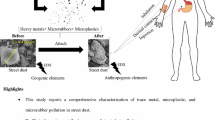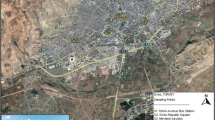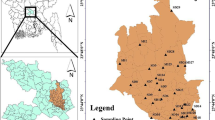Abstract
Deposition of dust particles on foliage surfaces helps to filter airborne dust particles that occur predominantly in areas near thermal power plants (TPPs). Highly dust-laden foliage surrounding TPPs is a serious issue affecting the vegetation and façade greening adversely. Fly ash (FA) generated by TPPs have an adverse impact on the growth and development of flora. Therefore, identification of their percentage contribution on foliar dust (FD) is of utmost importance. The present study attempted to identify all the contributing sources to FD. Morphological and chemical characterization of FD, FA, and road dust (RD) has been evaluated, followed by their multivariate statistical analysis. Contamination of FD from different sources was estimated by using field emission scanning electron microscope (FE-SEM) coupled with energy dispersive X-ray technique (EDX), Fourier transform infrared spectroscope (FTIR), and atomic absorption spectrophotometer techniques. Particle size distribution of FD revealed that the major portion of FD was <2 µm. FE-SEM and EDX analysis confirmed contamination of FD by FA, resuspension of RD, and local sources. FTIR peaks depicted the presence of different functional groups, including silica from nearby roads, saturated-nonsaturated, and aromatic organic functional groups originating predominantly from different activities of TPPs and traffic. Results of IR were in agreement with results obtained in physicochemical analyses. Heavy metals analysis of FA demonstrated high concentration of carcinogens Cr, Cu, Cd, and Ni and could be considered a marker to them. Certain heavy metals (Fe, Co, Mn, Pb, and Zn) were found to be in the order RD > FA > FD. This explores the necessity for considering other sources other than TPP sources. Principal component analysis (PCA) of heavy metals present in FD revealed that the sampling area was chiefly influenced from three sources: Bokaro thermal power station (55 %), RD (18 %), and local sources (27 %). Cluster analysis complemented the results of Pearson correlation matrix and PCA. Analyses illustrated the substantial influence of TPPs along with other source’s significance in contamination of FD.















Similar content being viewed by others
References
Agrawal M, Singh J (2000) Impact of coal power plant emission on the foliar elemental concentrations in plants in a low rainfall tropical region. Environ Monit Assess 60:261–282
Al-Khashman OA (2007) Determination of metal accumulation in deposited street dusts in Amman, Jordan. Environ Geochem Health 29:1–10
Al-Thyabat S, Miles NJ (2006) An improved estimation of size distribution from particle profile measurements. Powder Technol 166:152–160
Cai L, Xu Z, Ren M, Guo Q, Hu X, Hu G, Wan H, Peng P (2012) Source identification of eight hazardous heavy metals in agricultural soils of Huizhou, Guangdong Province, China. Ecotoxicol Environ Saf 78:2–8
Dubey PS, Pawar K, Shringi SK, Trivedi L (1982) The effects of fly ash deposition on photosynthetic pigments and dry matter production of wheat and gram. Agro Ecosyst 8:137–140
Govindaraju M, Ganeshkumar RS, Muthukumaran VR, Visvanathan P (2012) Identification and evaluation of air-pollution-tolerant plants around lignite-based thermal power station for greenbelt development. Environ Sci Pollut Res 19:1210–1223
Gunawardana C, Goonetilleke A, Egodawatta P, Dawes L, Kokot S (2012) Source characterisation of road dust based on chemical and mineralogical composition. Chemosphere 87:163–170
Jamil S, Abhilash PC, Singh A, Singh N, Behl HM (2009) Fly ash trapping and metal accumulating capacity of plants: implication for green belt around thermal power plants. Landsc Urban Plan 92:136–147
Liu L, Guan D, Peart MR, Wang G, Zhang H, Li Z (2013) The dust retention capacities of urban vegetation—a case study of Guangzhou, South China. Environ Sci Pollut R 20:6601–6610
Lu SG, Zheng YW, Bai SQ (2008) A HRTEM/EDX approach to identification of the source of dust particles on urban tree leaves. Atmos Environ 42:6431–6441
Maiti SK, Jaiswal S (2008) Bioaccumulation and translocation of metals in the natural vegetation growing on fly ash lagoons: a field study from Santaldih thermal power plant, West Bengal, India. Environ Monit Assess 136:355–370
Mazzoli A, Favoni O (2012) Particle size, size distribution and morphological evaluation of airborne dust particles of diverse woods by Scanning Electron Microscopy and image processing program. Powder Technol 225:65–71
Mazzoli A, Moriconi G (2014) Particle size, size distribution and morphological evaluation of glass fiber reinforced plastic (GRP) industrial by-product. Micron 67:169–178
McDonald AG, Bealey WJ, Fowler D, Dragosits U, Skiba U, Smith RI, Donovan RG, Brett HE, Hewitt CN, Nemitz E (2007) Quantifying the effect of urban tree planting on concentrations and depositions of PM 10 in two UK conurbations. Atmos Environ 41:8455–8467
Mishra LC, Shukla KN (1986) Effects of fly ash deposition on growth, metabolism and dry matter production of maize and soybean. Environ Pollut Series A Ecol Biol 42:1–13
Oliva SR, Espinosa AF (2007) Monitoring of heavy metals in top soils, atmospheric particles and plant leaves to identify possible contamination sources. Microchem J 86:131–139
Ottele M, Van Bohemen H, Fraaij A (2010) Quantifying the deposition of particulate matter on climber vegetation on living walls. Ecol Eng 36:154–162
Prajapati SK, Tripathi BD (2008) Anticipated performance Index of some tree species considered for green belt development in and around an urban area: a case study of Varanasi city, India. J Environ Manag 88:1343–1349
Prusty BA, Mishra PC, Azeezb PA (2005) Dust accumulation and leaf pigment content in vegetation near the national highway at Sambalpur, Orissa, India. Ecotoxicol Environ Saf 60:228–235
Qiu Y, Guan D, Song W, Huang K (2009) Capture of heavy metals and sulfur by foliar dust in urban Huizhou, Guangdong Province, China. Chemosphere 75:447–452
Rai PK, Panda LL (2014) Dust capturing potential and air pollution tolerance index (APTI) of some road side tree vegetation in Aizawl, Mizoram, India: an Indo-Burma hot spot region. Air Qual Atmos Health 7:93–101
Rai PK, Chutia BM, Patil SK (2014) Monitoring of spatial variations of particulate matter (PM) pollution through bio-magnetic aspects of roadside plant leaves in an Indo-Burma hot spot region. Urban For Urban Gree 13:761–770
Raja R, Nayak AK, Rao KS, Puree C, Shahid M, Panda BB, Lal B (2014) Effect of fly ash deposition on photosynthesis, growth and yield of rice. Bull Environ Contam Toxicol 93:106–112
Ram SS, Majumdar S, Chaudhuri P, Chanda S, Santra SC, Maiti PK, Sudarshan M, Chakraborty A (2012a) SEMEDS: an important tool for air pollution biomonitoring. Micron 43:490–493
Ram SS, Majumdar S, Chaudhuri P, Chanda S, Santra SC, Maiti PK, Sudarshan M, Chakraborty A (2012b) Plant canopies: bio–monitor and trap for re–suspended dust particulates contaminated with heavy metals. Mitig Adapt Strat Global Change 19:499–508
Ram SS, Kumar RV, Chaudhuri P, Chanda S, Santra SC, Sudarshan M, Chakraborty A (2014) Physico–chemical characterization of street dust and re–suspended dust on plant canopies: an approach for finger printing the urban environment. Ecol Indic 36:334–338
Sarkar A, Rano R, Mishra KK, Sinha IN (2005) Particle size distribution profile of some Indian fly ash—a comparative study to assess their possible uses. Fuel Process Technol 86:1221–1238
Sarkar A, Rano R, Udaybhanu G, Basu AK (2006) A comprehensive characterisation of fly ash from a thermal power plant in Eastern India. Fuel Process Technol 87:259–277
Sawidis T, Krystallidis P, Veros D, Chettri M (2012) A study of air pollution with heavy metals in Athens city and Attica basin using evergreen trees as biological indicators. Biol Trace Elem Res 148:396–408
Schleppi P, Tobler L, Bucher JB, Wyttenbach A (2000) Multivariate interpretation of the foliar chemical composition of Norway spruce (Picea abies). Plant Soil 219:251–262
Seyyednejad SM, Niknejad M, Koochak H (2011) A review of some different effects of air pollution on plants. Res J Environ Sci 5:302–309
Sharma AP, Tripathi BD (2009) Biochemical responses in tree foliage exposed to coal-fired power plant emission in seasonally dry tropical environment. Environ Monit Assess 158:197–212
Simon E, Braun M, Vidic A, Bogyó D, Fábián I, Tóthmérész B (2011) Air pollution assessment based on elemental concentration of leaves tissue and foliage dust along an urbanization gradient in Vienna. Environ Pollut 159:1229–1233
Singh LP, Siddiqui ZA (2003) Effects of Alternaria triticina and foliar fly ash deposition on growth, yield, photosynthetic pigments, protein and lysine contents of three cultivars of wheat. Bioresour Technol 86:189–192
Song Y, Maher BA, Li F, Wang X, Sun X, Zhang H (2015) Particulate matter deposited on leaf of five evergreen species in Beijing, China: source identification and size distribution. Atmos Environ 105:53–60
Standard ISO 9276-1 (1998) Representation of results of particle size analysis—part 1: graphical representation, Available for electronic purchase and download from: http://www.iso.org/iso/home/store/cataloguetc/cataloguedetail.htm?csnumber=25860
Sternberg T, Viles H, Cathersides A, Edwards M (2010) Dust particulate absorption by ivy (Hedera helix L) on historic walls in urban environments. Sci Total Environ 409:162–168
Sushil S, Batra VS (2006) Analysis of fly ash heavy metal content and disposal in three thermal power plants in India. Fuel 85:2676–2679
Suzuki K (2006) Characterisation of airborne particulates and associated trace metals deposited on tree bark by ICP–OES, ICP–MS, SEM–EDX and laser ablation ICP–MS. Atmos Environ 40:2626–2634
Tomašević M, Vukmirović Z, Rajšić S, Tasić M, Stevanović B (2005) Characterization of trace metal particles deposited on some deciduous tree leaves in an urban area. Chemosphere 61:753–760
Tomeczek J, Palugniok H (2002) Kinetics of mineral matter transformation during coal combustion. Fuel 81:1251–1258
Yan J, Lin L, Zhou W, Han L, Ma K (2016a) Quantifying the characteristics of particulate matters captured by urban plants using an automatic approach. J Environ Sci 39:259–267
Yan J, Lin L, Zhou W, Ma K, Pickett ST (2016b) A novel approach for quantifying particulate matter distribution on leaf surface by combining SEM and object-based image analysis. Remote Sens Environ 173:156–161
Yin S, Shen Z, Zhou P, Zou X, Che S, Wang W (2011) Quantifying air pollution attenuation within urban parks: an experimental approach in Shanghai, China. Environ Pollut 159:2155–2163
Zheng Y, Gao Q, Wen X, Yang M, Chen H, Wu Z, Lin X (2013) Multivariate statistical analysis of heavy metals in foliage dust near pedestrian bridges in Guangzhou, South China in 2009. Environ Earth Sci 70:107–113
Acknowledgments
The authors are grateful to Indian School of Mines, Dhanbad, to facilitate laboratory facilities for conducting experiments.
Author information
Authors and Affiliations
Corresponding author
Rights and permissions
About this article
Cite this article
Manisha, H., Suresh Pandian, E. & Pal, A.K. Determining the Contribution of Nearby Power Plants to Deposited Foliar Dust: A Case Study of BTPS, Bokaro. Arch Environ Contam Toxicol 71, 485–499 (2016). https://doi.org/10.1007/s00244-016-0309-1
Received:
Accepted:
Published:
Issue Date:
DOI: https://doi.org/10.1007/s00244-016-0309-1




